






USDA scientist Ondulla Toomer is exploring how incorporating peanuts into poultry feed can enhance the nutritional quality of both eggs and poultry meat.
20 | FPPA ANNOUNCES NEW EXECUTIVE DIRECTOR
The Florida Peanut Producers Association has hired Jackson County native Brittany Green as their new executive director.
The University of Georgia breaks ground on the Grand Farm, a new agriculture innovation partnership.


The Peanut Irrigation Guidebook provides information on irrigation tips for 2025, soil moisture sensors, irrigation logistics, SmartIrrigation CropFit App, water withdrawal permit updates and the Master Irrigator Program in Georgia and Mississippi.

Southeastern Peanut Farmer is published six times a year (Jan./Feb., March, April, May/June, July/Aug., and Oct./Nov.) by the Southern Peanut Farmers Federation. The publisher is not responsible for copy omission, typographical errors, or any unintentional errors that may occur, other than to correct it in the following issue. Any erroneous reflection which may occur in the columns of Southeastern Peanut Farmer will be corrected upon brought to the attention of the editor. (Phone 229-386-3690.)
Postmaster: Send address changes (Form 3579) to Southeastern Peanut Farmer, P.O. Box 706, Tifton, Georgia, 31793.

Farming isn't just a job. It's a calling. It's long hours, unpredictable weather, fluctuating markets, rising costs, and the weight of legacy, often all at once. In a profession built on resilience, we don't often talk about the toil it takes. But we should. Because while crops, livestock, and equipment need care—so do the farmers behind them.
In recent years, "farm stress" has become a term we're hearing more often, and for good reason. Farming is a stressful occupation that is associated with increased levels of anxiety and depression. Experiences such as natural disasters, extreme weather events, financial uncertainty, fluctuating markets, labor shortages, trade disruptions and other factors all contribute to extreme stress for farmers and ranchers who often live in a very isolated setting.
According to the American Farm Bureau Federation, multiple studies show that farmer suicide rates are 2-5x higher than the national average. That’s a staggering and heartbreaking fact—one that should shake us all out of silence. Stress on the farm isn't a weakness. It's real. And acknowledging it is the first step toward thriving, not just surviving.
So what does thriving look like?
Thriving doesn't mean everything's perfect. It means finding balance in a life where perfection isn't an option. It means making time—for family, faith, hobbies, and rest—even during the busiest seasons. It means recognizing when you're stretched too thin and being willing to ask for help, whether from a neighbor, a local Extension agent, or a mental health professional.
Resources are out there. Many Extension offices now offer stress management programs, financial counseling, and community workshops. Rural mental health hotlines offer confidential, 24/7 support—and a friendly voice when you need it most. If you or someone you know is in crisis, call or text 988 or visit 988lifeline.org.
And let's not underestimate the power of simply talking to each other. A quick conversation in the parking lot, a check-in over coffee, or a word of encouragement at church can mean more than we realize.
As we move into another growing season, let's keep our eyes not just on our farm, crop or livestock, but on each other. A strong farm needs a strong farmer. And a strong community helps make both possible.
Stay safe. Stay well. And remember— you're not alone.

USA Peanut Congress
June 9-12, 2025, Nashville, Tenn. For more information call 229-888-2508 or visit peanut-shellers.org.
American Peanut Research and Educational Society
July 15-17, 2025, Richmond, Va. For more info visit apresinc.com.
Southern Peanut Growers
July 23-25, 2025, Edgewater Beach Resort, Panama City Beach, Fla. For more info visit southernpeanutfarmers.org.
C.M. Stripling Irrigation Research Park
Field Day
July 24, 2025, Camilla, Ga. For more info visit striplingpark.caes.uga.edu or call 229522-3623.
American Peanut Shellers Association and National Peanut Buying Points Association Pre-Harvest Meeting
Aug. 19-20, 2025, Albany, Ga. For more information call 229-888-2508 or visit peanut-shellers.org.
Brooklet Peanut Festival
Sept. 20, 2025, Brooklet, Ga. For more information visit the festival's website at brookletpeanutfestival.com.
Plains Peanut Festival
Sept. 27, 2025, Plains, Ga. For more information call visit the festival's website at jimmycarterfriends.org.
Georgia National Fair
Oct. 2-12, 2025, Perry, Ga. For more info visit georgianationalfair.com.
Sunbelt Ag Expo
Oct. 14-16, 2025, Moultrie, Ga. For more info visit sunbeltexpo.com.
Florida Farm Bureau Annual Meeting
Oct. 27-29, 2025, Hilton Daytona Beach Oceanfront Resort, Daytona Beach, Fla. For more information visit floridafarmbureau.org.
SEPF Editor

produce these ingredients needed for poultry production regionally," Toomer says. "Thus, the use of peanuts in poultry feed ingredients may serve to enhance the nutritional quality of the chicken breast that's produced, as well as the eggs, while also supporting greater sustainable community focused agriculture."
Over the last eight years, Toomer has conducted seven layer hen high-oleic feeding trials, three broiler high-oleic feeding trails and two fish high-oleic feeding trials.
Toomer's research has focused on replacing soybean meal entirely with peanuts and supplementing the soybean meal diet with 5 percent, 10 percent, 15 percent or 20 percent unblanched high-oleic peanuts. The studies started small within Toomer's building but has expanded out to the farm with 100 hens per treatment group.
"Eggs produced from hens fed a 20 percent high-oleic peanut replacement diet had superior yolk color and nutritional value..."
Ondulla Toomer
Through the studies, Toomer has noticed no differences in body weights, total egg production, egg weights or feed conversion. However, the results have shown some observable differences in egg yolk color when peanuts are added to the diet.
"Eggs produced from hens fed a 20 percent high-oleic peanut replacement diet had superior yolk color and nutritional value as compared to conventional eggs, with 50 percent more Beta-Carotene (Vitamin A) and 40 percent increased yolk color," Toomer says.
Additionally, hens fed the 20 percent high-oleic peanut replacement diet had 22 percent more heart healthy monounsaturated fatty acids and 19 percent reduced saturated fat content as compared to the conventional eggs.
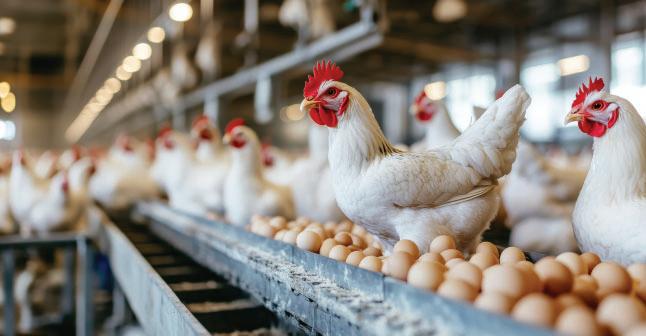
Eggs produced from hens fed a 20 percent high-oleic peanut replacement diet had superior yolk color and nutritional value as compared to convetnional eggs, with 50 percent more Beta-Carotene (Vitamin A) and 40 percent increased yolk color.
Toomer also studied the change in chicken breast meat when fed a diet of high-oleic peanuts. She noticed a visible difference in the appearance of the meat when fed a 10 percent higholeic peanut supplemented diet.
The 10 percent supplemented diet had chicken breast enriched with 56 percent increased unsaturated fatty acid content and 25 percent less saturated fat as compared to conventional poultry meat. However, feed conversion ratio, carcass weights and cut-up components were smaller in birds fed the high-oleic peanut supplemented diet when compared to the conventional diet fed to birds.
The research is promising so the next steps are determining the feed costs associated with using high-oleic peanuts along with the best way to incorporate peanuts into the feeding plans for the poultry industry.
"Just a small inclusion level would help the peanut industry and provide economic opportunities also while utilizing this annual over supply of peanuts. Utilizing this over supply would then drive the price of these carryover stocks such that they would be additional economic profits," Toomer says. "Market expansion of domestic peanuts beyond just the utilization of food would be beneficial to the peanut industry."
In 2022 there were 305 million layers in the U.S. and if high-oleic
peanuts were included at 5 percent inclusion in the layer diets that would utilize 700,000 tons of peanuts annually in the U.S. at a price of $437 million.
In addition to the peanut industry benefits, the poultry industry can see benefits too. In the studies where the birds were fed peanut diets, there were no mortalities. The birds are receiving high-quality protein and a great deal of dietary energy. Additionally, the poultry industry benefits from improved nutritional quality of eggs and poultry meat products, and finished poultry feed containing high-oleic peanuts has extended shelf life with reduced rancidity as compared to conventional poultry feed.
In the end, the consumer also benefits with improved nutritional quality of eggs and poultry meat, enriched with monounsaturated fatty acids, reduced saturated fats, and the potential enrichment of eggs with beta-carotene.
Toomer is also beginning research, funded by the Georgia Peanut Commission, to explore the use of whole normal-oleic peanuts as a livestock feed ingredient.
"The peanut industry needs to work together to find the best system to incorporate peanuts into broiler and layer feed and provide new opportunities for farmers," Chase says.



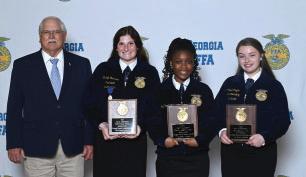
Rodney Dawson, Georgia Peanut Commission board member, presents the Star in Agriscience FFA Award to Caileigh Goldstein, state winner from Walnut Grove, Joy Sanders, central region winner from Warner Robins, and Abigail Griffin, south region winner from Berrien County.
The Georgia Peanut Commission and The Peanut Institute teamed up to sponsor the Georgia FFA Star in Agriscience Award during the state convention held in Macon, Georgia. The State Star in Agriscience Award was presented to Caileigh Goldstein from Walnut Grove FFA. The additional state finalists included Joy Sanders from Warner Robins FFA and Abigail Griffin from Berrien County FFA.
The Georgia Peanut Commission also exhibited during the two-day career show. The event provided GPC with an opportunity to showcase the various careers within the peanut industry.

of Georgia students Jamie
The Georgia Peanut Commission partnered with the University of Georgia's Sustainability Certificate program's students in a capstone project focused on finding new markets for peanuts. Three students composed a resource guide titled, "New Market Research." This guide reviews historical peanut production and current market trends through the team's interviews with subject matter experts, farm visitis and additional resources. Through the capstone project, the students recommend new opportunities for farmers including sustainable marine biofuel, poultry feed and bioplastics. The students presented their findings and won second place at the UGA Sustainability Showcase, May 3, 2025, in Athens, Georgia.
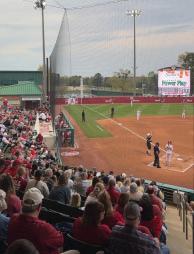
The Alabama Peanut Producers attended multiple baseball and softball games across the state to promote peanuts. APPA's partnership with the University of Alabama included an exhibit and fun peanut activities at a softball game on March 28. On the same night, packs of Alabama peanuts were handed out at an Auburn University softball game by the Diamond Dolls. Also on March 28, Billy Hixon, APPA board member and peanut farmer, attended a Troy University baseball game along with his family, where his two grandsons had the opportunity to throw the first pitches. APPA will continue to be present at the University of Alabama and Auburn University baseball and softball games throughout the season. Peanuts are a great source of protein for athletes and fans of all ages as they cheer on their favorite team.

The Georgia Peanut Commission sponsored a capstone project with a team of University of Georgia engineering students. The team consists of Dylan Freireich, Timothy Cloar, Emilia Reber, Drew Turley and Kyle Bak. The team focused on improving a small-scale, on-site peanut processing system which roasts peanuts.

University of Georgia engineering students discuss the small-scale automated peanut processing system to judges at the Capstone Design Showcase, April 23, in Athens, Ga.
The initial prototype of the system was developed by a senior design team in the 2022-2023 school year and has been adapted by a team of engineering students each year. The system can be adapted to produce various peanut products allowing farmers the opportunity to produce market-ready products for the consumer. The 2024-2025 team completed Phase III of the processing system for on-site roasting of peanuts, which would allow farmers a way to process peanuts and sell directly to consumers.
Students worked on their capstone projects from August 2024 until April 2025. The students display their prototypes, designs and solutions developed for their projects at the Capstone Design Showcase held April 23, 2025. Projects are evaluated by a judging team of engineering professionals in both industry and academia.
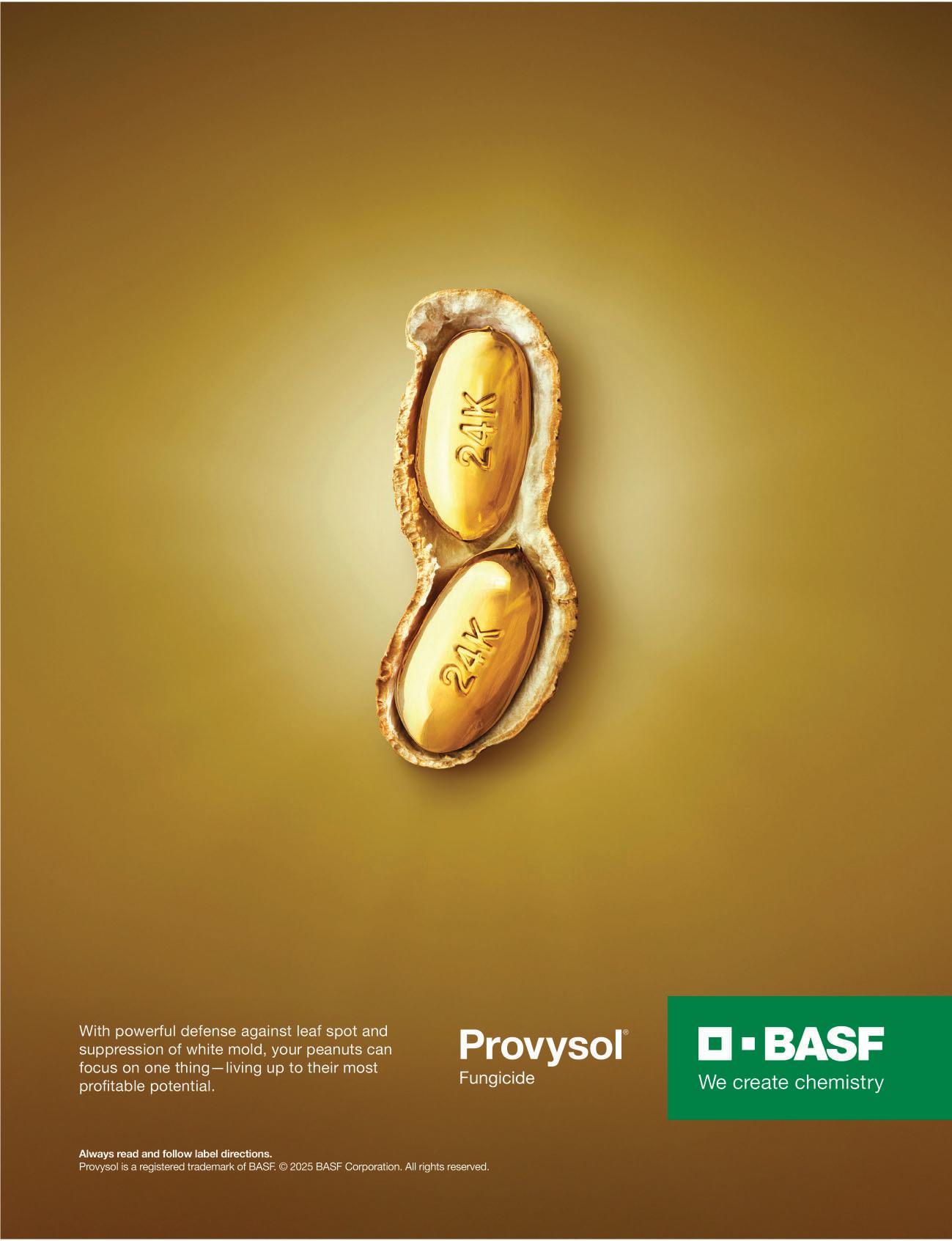
Research at Stripling Irrigation Research Park focuses on finding irrigation techniques that maximize yield and profitability for peanut producers
By Wes Porter and Hannah Grubbs University of Georgia
Precision agriculture technology adoption has been on the rise to improve yields, efficiency, and profitability. Irrigation scheduling is no exception. Soil moisture sensing technologies are aiding producers in scheduling irrigation with less guesswork and more precision. Some current scheduling methods lack scientific basis which can result in the under or over application of water. Both can result in decreased yields, profitability, and irrigation water use efficiency.
Research at Stripling Irrigation Research Park (SIRP) in Camilla, Georgia, conducted by Wes Porter, University of Georgia Extension precision ag and irrigation specialist, continues to focus on finding irrigation techniques that maximize yield and profitability for our producers. In previous years, peanut irrigation research has indicated a 45 kPa soil water tension (SWT) as the optimal SWT threshold for sandy loam soils and reporting the highest in irrigation water use efficiency.
Another concept introduced is that peanuts can be acclimated
to mild drought stress during preflowering and vegetative stages. Peanuts have been shown to be the least sensitive to drought stress during this stage. An acclimated peanut plant could form deeper rooting systems in search of water which could benefit them if plants experience late-season drought stress.
In 2024, peanut irrigation research using the Georgia-06G peanut variety focused on using SWT sensors to change irrigation thresholds based on growth stage to further maximize yield and profitability in peanut production. SWT refers to the force required for plant roots to extract water from the soil profile, not a total water content within the soil. A lower number correlates to a more saturated soil condition, meaning it is easier for plant roots to take up water.
Key crop growth phases have been identified as 0-40, 41-110, and 111-harvest days after planting based on flowering and entering maturity. Treatments are based on simulating wet (20 kPa), optimal (45 kPa), and dry (70 kPa) soil conditions for sandy loam soils, while being the most predominate soil type in Georgia.
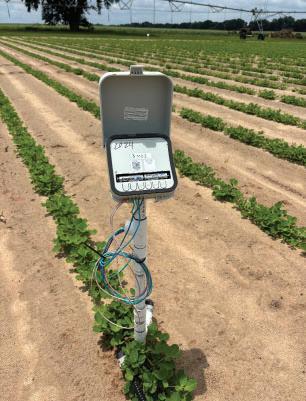
kPA45 kPA
720 kPA70 kPA45 kPA
845 kPA70 kPA70 kPA
Probes installed in this study were comprised of three Watermark SWT (soil water tension) sensors at depths of 4, 12, and 20 inches. As the root zone progressed, averages were weighted differently. For example, the 4-inch depth was weighted the most during the early season and gradually dispersed to deeper depth as roots developed throughout the season. These probes logged SWT data hourly and weighted averages from 6:00 a.m. were used to determine whether to apply irrigation each day.
Results from 2024 currently show no clear recommended irrigation regimen due to no significant differences between irrigated treatments, but some key trends were identified. First, mild drought stress during pre-flowering vegetative stages resulted in yield maintenance and increased profitability due to potentially fewer irrigation events. Second, premature end of season irrigation termination had negative impacts on yield.
When producers begin digging one field, it is important to not terminate irrigation for all fields, especially when it could take weeks to complete harvest across all acres. The end of season is a stressful time already, the last thing a producer needs is reductions in yield after working hard all season from not properly finalizing irrigation.
45/45/45 kPA12.006426a 1594ab 1558
70/45/70 kPA12.005944ab 1467ab 1431
70/45/45 kPA12.756496a 1606a 1568
70/45/20 kPA 12.756490a 1605a 1566
45/45/70 kPA10.505979ab 1489ab 1458
70/20/45 kPA12.756083a 1497ab 1459
20/70/45 kPA11.256078a 1509ab 1475
45/70/70 kPA9.756322a 1587ab 1558
Rainfed0.004631b 1227b 1227
Similar letters beside data indicate statistical significance at the a=0.05 level. No letters indicate no statistically significant difference. Profitability/E and profitability/D represent electric and diesel systems, respectively.
Because of the potential significance of yield loss from premature irrigation termination, a secondary study will be initiated during 2025 at SIRP. This study will focus on demonstrating yield and
profit reductions caused by dry end of season soil conditions or walking away from irrigation too early at the end of the season. This information will be valuable for producers in the Southeast to irrigate more effectively
and avoid any unnecessary yield and profit reductions.
Porter and the UGA Extension Service remain committed to seeking ways to improve the methods of irrigation for Southeastern peanut producers and soil moisture sensors are offering valuable insight.
Research from SIRP in 2024 assessed tailoring irrigation needs to specific growth stages using SWT sensors. While no clear irrigation schedule came from this study, soil moisture trends and their effects on yield and producer profitability have been identified. In the upcoming season, we plan to repeat this study and introduce another study to prevent producers from losing yield and profitability due to premature irrigation termination or dry soil conditions in the late season.
Earlier this year, Valley Irrigation announced the release of a next-evolution app that consolidates four legacy irrigation technology systems –AgSense, Valley 365, PrecisionKing and PivoTrac – into AgSense 365.
"AgSense 365 brings together the best features and controls from our existing legacy systems for an unparalleled user experience," says Craig Bell, senior director of digital products at Valley Irrigation. "This rebrand and consolidation will drive greater efficiencies for our growers, who can now monitor and control their irrigation business with one intuitive, featurerich and user-friendly interface."
Valley Irrigation has leveraged over 10 years of customer feedback to create the evolved AgSense 365 app. This feedback highlighted a distinct need for an intuitive and easy–to–use platform that would save time, increase productivity and eliminate the hassle of managing multiple platforms simultaneously.
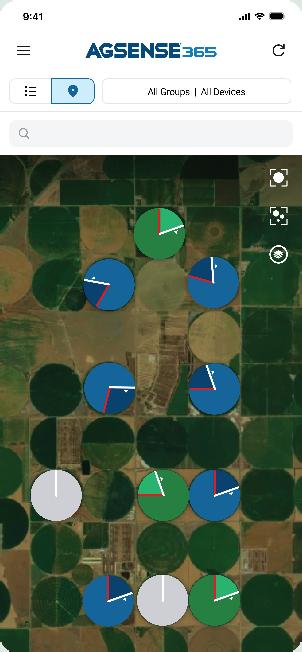

"As growers are increasingly challenged to produce more with fewer resources to meet the needs of our growing world population, AgSense 365 enables them to easily know the current status of their irrigation operation from anywhere in the world, no matter what brand of hardware they have," Bell says.
"Additionally, it brings key enhancements that underscore our commitment to elevating our technology based on actionable feedback."
"We are proud to bring AgSense 365 to the market as it represents an exciting new chapter in irrigation technology," says Ashley Anderson, assistant general manager of AgSense, Valley Technology. "With real-time remote monitoring and control capabilities, growers can save time, apply water when and where it is needed, adding greater efficiency to their operations."
Anderson adds that the platform is also built with the future in mind. It will evolve alongside grower operations and needs with further consolidation and added functionality to ensure farmers stay ahead of the curve in an increasingly data-driven world.
For more information about AgSense 365, visit valleyirrigation. com/agsense365.

C.M. Stripling Irrigation Research Park
ast year was a milestone year for Amilcar Vargas. He earned a doctorate in agronomy from Mississippi State University, focusing on row crop water management strategies, and welcomed his daughter, Elena Isabel, into the world—just before joining the University of Georgia.
Amilcar Vargas was named superintendent of the C.M. Stripling Irrigation Research Park in Camilla, Georgia, Sept. 1, 2024. Vargas also directs the work at the University of Georgia Attapulgus Research and Education Center.
What is your educational background and work experience?
I’m originally from Guatemala, and my journey in the U.S. began 12 years ago when I joined The Ohio State University (OSU) as a research scholar, contributing to an irrigation study in the Department of Entomology. Over the following years, I earned a master’s degree in plant pathology at OSU. After graduating, I worked in Puerto Rico with Bayer CropScience as an integrated pest management specialist, then returned to OSU as a research associate in the Vegetable Pathology Program.
What drew you to the opportunity at Stripling Irrigation Research Park?
I have a strong passion for irrigation, and the C.M. Stripling Irrigation Research Park is the only state-of-the-art irrigation research facility located east of the Mississippi River. Working at this facility gives me

Amilcar Vargas began his role as superintendent of the University of Georgia's C.M. Stripling Irrigation Research Park in Camilla, Ga., Sept. 1, 2024. A native of Guatemala, Vargas shares a passion for irrigation research with his combination of academic and practical experiences.
the opportunity to collaborate with a multidisciplinary team to address both local and regional water issues.
Will you share more about your background and hands-on experience in irrigation research and technology?
My background in irrigation is a combination of academic and practical experiences. I have worked in projects focused on improving water use efficiency, irrigation management, and evaluating the performance of different irrigation methods under varying climatic and soil conditions. Additionally, I have experience working with remote sensing technologies such as soil moisture sensors and variable rate irrigation systems.
What goals or vision do you have for the future of Stripling Irrigation Research Park?
I envision the C.M. Stripling Irrigation Research Park as a leading research facility in irrigation and precision agriculture research — addressing local and regional challenges such as water scarcity and promoting water management practices.


By Marjie Roquemore Georgia Environmental Protection Division
overnor Brian Kemp of Georgia announced Dec. 18, 2024 that the Georgia Environmental Protection Division (EPD) has modified the 2012 suspension of agricultural water withdrawal permits in portions of the Lower Flint and Chattahoochee River Basins. This allows the first new agricultural water withdrawal permits in this area to be issued in over a decade.
Georgia EPD began accepting applications April 1, 2025, for groundwater withdrawal permits that will include drought-related measures to continue ensuring the long-term well-being of water resources essential to Georgia farmers. In addition, EPD began accepting applications for permits without drought restrictions to those agricultural water users with unpermitted acres and sources put into irrigation prior to the 1999 or 2012 suspension.
The EPD Watershed Protection Branch (WPB) staff has made the following recommendations that were approved by the Governor and EPD Director Jeff Cown for modifying the 2012 suspension.
1.
WPB recommends maintaining the 2012 suspension on surface water withdrawals, except for surface water withdrawals from the Suwannee and Ochlockonee River Basins. While additional surface water withdrawals from the Suwannee and Ochlockonee River Basins would have no impact on stream flows in the Flint River Basin, surface water withdrawals from the Flint River and its tributaries would have a direct impact. Additional surface water withdrawals from the Flint and Chattahoochee River Basins in the 2012 suspension area could lead to negative effects on other users and the water resource.
2.
WPB recommends permitting new or expanded withdrawals from the Floridan aquifer in the 2012 suspension area on the condition that the permits include all statutory and regulatory requirements and restrictions on withdrawals in times of drought. This modification to the 2012 suspension would be protective of existing users and the resource in times of drought, while allowing some opportunity for new acres to be irrigated under normal and wetter weather conditions. Technical assessment of this proposed change indicates virtually no impact beyond the 2011-2012 drought. WPB began accepting applications for new or expanded withdrawals from the Floridan aquifer in the 2012 suspension area for drought-restricted permits on April 1, 2025.
3.
WPB recommends providing permits without drought restrictions to those agricultural water users with unpermitted acres and sources put into irrigation prior to the 1999 or 2012 suspension. The permits must be consistent with the 2006 Flint River Basin Plan and current statutory requirements, including irrigation efficiency and 25-year permit terms. For the red zone, only acres and sources put into irrigation before December 1999 will be considered. For the green and yellow zones, only acres and sources put into irrigation before July 30, 2012, will be considered. This approach maintains the same overall drought-time irrigated acreage as assessed in the U.S. Supreme Court case of Florida vs. Georgia.
4.

WPB recommends a strong emphasis on addressing noncompliance with agricultural water withdrawal requirements. The noncompliance with issued permits or withdrawing water without a permit creates significant risk not only for the person engaged in noncompliance, but for the entire agricultural community. Unpermitted acres or sources will be addressed through compliance pathways that will reduce the load on the water resources, particularly in times of drought. EPD is offering multiple tools to ensure all users in the basin are able to comply including drought restricted permits, volumetric permits, acre trading, permit corrections and permit modifications. Again, the successful implementation of this compliance program will help maintain the same overall drought-time irrigated acreage as assessed and affirmed by the Supreme Court's 2021 decision.
5.
WPB recommends continuing support of the Habitat Conservation Plan development, submittal, and approval process. The Habitat Conservation Plan process allows EPD the opportunity to build more knowledge about the 2012 suspension area and implement projects that will provide protection to existing users and the water resources. The acceptance of Georgia's Habitat Conservation Plan and the issuance of an Incidental Take Permit by the U.S. Fish and Wildlife Service will ensure the protection of endangered species while providing long-term stability and protection of Georgia's agricultural permitting practice as well as the permitted farming community.
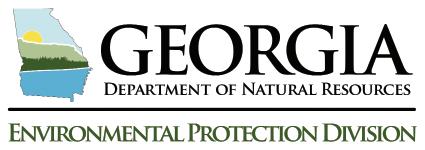
EPD encourages all farmers in Georgia, but particularly the Lower Flint River Basin to contact the Agricultural Water Withdrawal Program in Tifton at 229-391-2400 or ag.permits@dnr.ga.gov for more information on new and modified permit options.
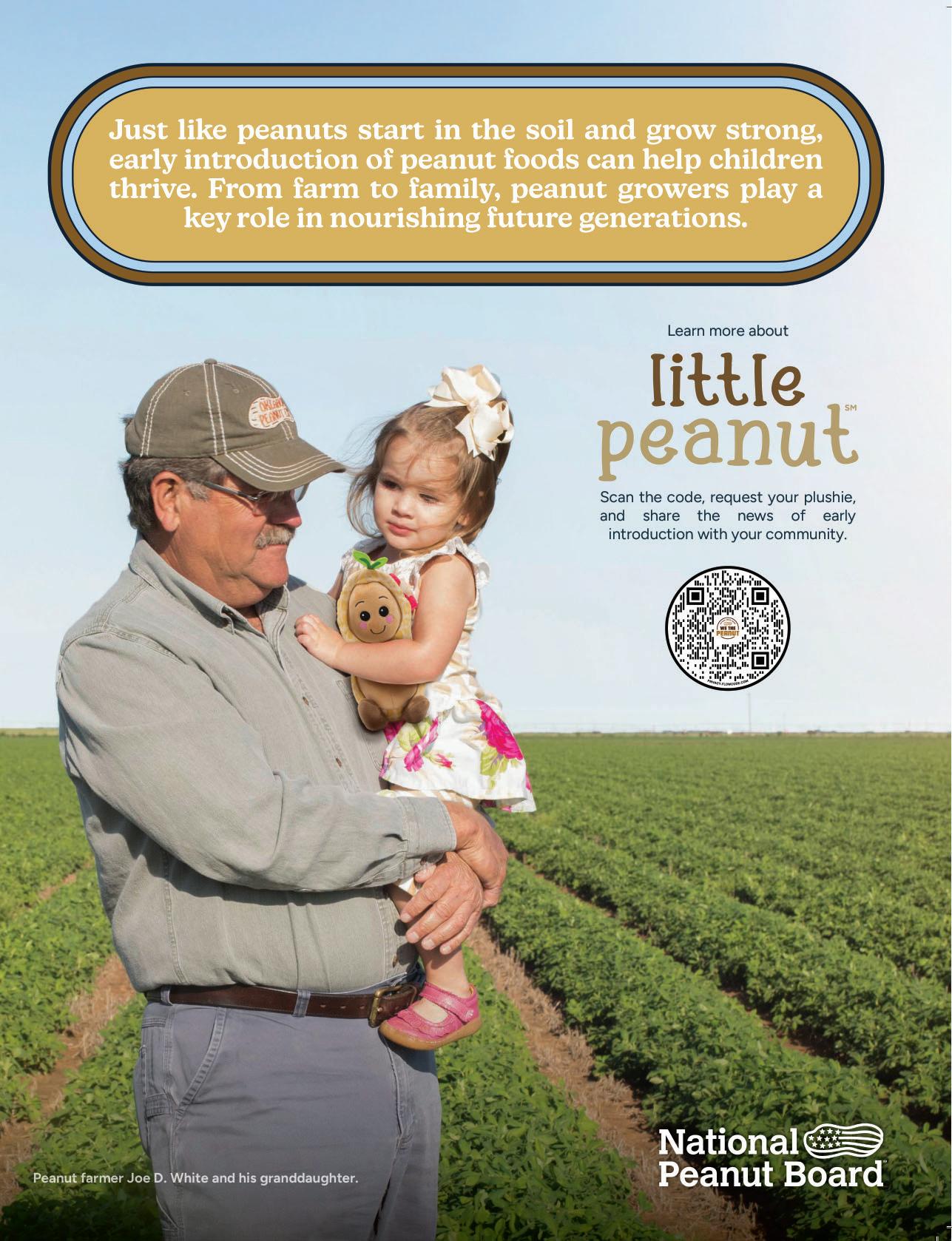
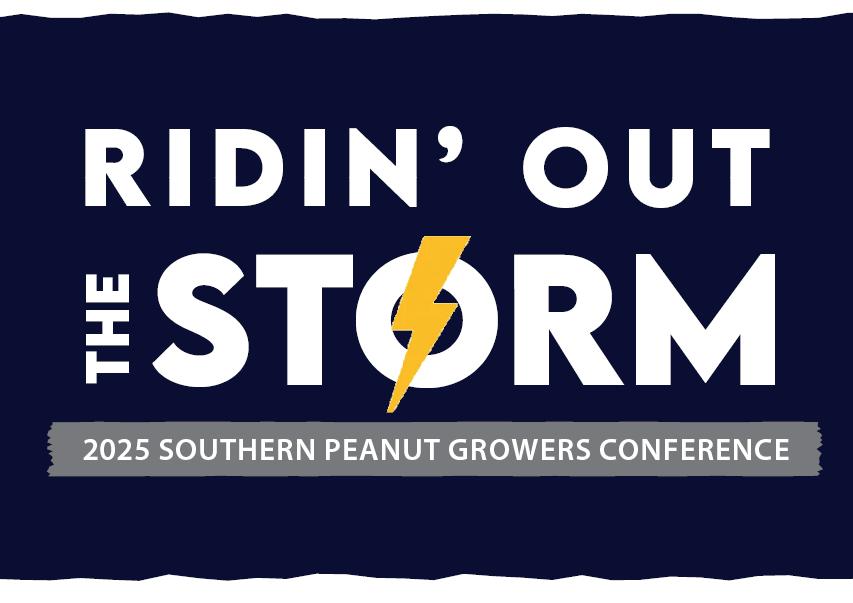
Mark your calendars for the 26th Annual Southern Peanut Growers Conference, July 23-25, 2025, at the Edgewater Beach & Golf Resort, Panama City Beach, Florida. This year’s conference offers farmers an opportunity to learn more about legislative issues, peanut promotions and production issues.
The registration fee for growers is $275 which includes all conference events and meals. The registration deadline is June 15. The registration fee increases by $75 on June 16. The theme for this year’s conference, “Ridin' out the Storm,” plans to focus on EPA's new herbicide strategy and a Washington update.
The conference schedule and registration information is available at southernpeanutfarmers.org
Wednesday, July 23
3:00 - 5:00 p.m.
6:30 p.m.
7:00 p.m.
Thursday, July 24
7:00 a.m.
8:30 a.m.
10:00 a.m.
10:30 a.m.
10:30 a.m.
Conference Registration
Welcoming Reception
Welcome Dinner
Prayer Breakfast
Jeb Smith, founding pastor of God’s Way Baptist Church in Hastings, Florida and President of Florida Farm Bureau
General Session I
EPA's New Herbicide Strategy
Dr. Taylor Singleton, University of Georgia
Dr. Mark Abney, University of Georgia
Dr. Wilson Faircloth, Syngenta
Refreshment Break
Ladies Program - Cookie Decorating
General Session II
Farmer's Attitudes
Dr. Scott Monfort, University of Georgia and Extension Specialists from the Southeast Noon Luncheon
Featuring the World's Most Famous Peanut Farmer - Billy Senkbeil, Sylvester, Georgia

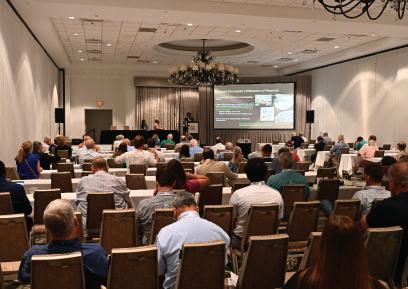
Friday, July 25
7:00 a.m.
9:00 a.m.
Farm Press Peanut Efficiency Awards Breakfast
General Session III
Peanut Policy & Economics
Bob Redding, The Redding Firm
Peanut Producer Panel
10:15 a.m. Refreshment Break
Noon Lunch on your own and afternoon free!
7:00 p.m. Reception
7:30 p.m.
Dinner & Entertainment Featuring Glory Days

The Southern Peanut Farmers Federation (SPFF) proudly welcomes the South Carolina Peanut Board to join the federation. Formed in 1998, SPFF was established to allow Southeastern peanut producers to speak with a unified voice on legislative issues and partner with other state peanut organizations for leadership development and coordinated research funding.
“The South Carolina Peanut Board is excited to join the Southern Peanut Farmers Federation to offer the South Carolina peanut industry so many opportunities,” says Richard Rentz, chairman of the South Carolina Peanut Board. “By joining SPFF, South Carolina is taking a step towards the peanut industry working together as a whole.”
SPFF was initially organized by the Alabama Peanut Producers Association, the Florida Peanut Producers Association and the Georgia Peanut Commission. The Mississippi Peanut Growers Association joined SPFF in 2008 and now the South Carolina Peanut Board is the latest organization to join SPFF. The SPFF board consists of 10 members comprised of the chief elected officer and the executive director of each organization.
“We are very pleased to have South Carolina join the federation so we can expand our partnership and collaboration on peanut industry issues and help us to be a stronger advocate for growers,” says Joe Boddiford, chairman of the Georgia Peanut Commission.
The peanut farmers in Alabama, Florida, Georgia, Mississippi and South Carolina produce 73 percent of the nation’s peanuts. In 2024, farmers in the five states produced an average of 3,560 pounds of peanuts per acre.
The Southern Peanut Farmers Federation coordinates the annual Southern Peanut Growers Conference, the Peanut Leadership Academy, congressional member and staff relations, as well as research initiatives. Additionally, SPFF publishes the Southeastern Peanut Farmer magazine which is distributed to peanut farmers across the Southeast.
Additional information regarding the Southern Peanut Farmers Federation is available online at www. southernpeanutfarmers.org.
By Robert L. Redding Jr.
USTR Ambassador testifies before Congress on U.S. Trade Policy Agenda
The U.S. Senate Committee on Finance and the U.S. House Committee on Ways and Means each recently held full committee hearings titled "The President's 2025 Trade Policy Agenda" with U.S. Trade Representative Ambassador Jamieson Greer as a witness.
During the Senate Committee on Finance hearing, April 8, 2025, Ambassador Greer stated, "Our agricultural trade balance – which historically resulted in trade surpluses for our farmers – was in deficit the last two years of the Biden Administration and likely will take some time to recover."
"One important driver of these negative trends has been unfair, unbalanced, and non-reciprocal trade. This includes the effect of higher tariffs imposed by other countries on the United States, the effect of non-tariff measures that promote other countries' exports and obstruct U.S. exports, and other foreign economic policies favoring overproduction and degrading America's manufacturing capacity," he added.
U.S. Peanut Federation supports bill to modernize
On March 25, 2025, U.S. Reps. Barry Moore, R-Ala., and Don Davis, D-N.C., re-introduced bipartisan legislation establishing a commission to modernize the National Agricultural Statistics Service (NASS). NASS statistics are widely used by groups looking for credible data to inform products, services, decisions, and outcomes. These groups include producers, insurance adjusters, commodity traders, federal agencies, and policy makers. The U.S. Peanut Federation and Alabama Peanut Producers Association signed in support of this legislation.
"Data provided by the National Agricultural Statistics Service is critical to help producers and stakeholders make informed decisions," says Rep. Moore. "Establishing a commission to modernize NASS' function will help the Department of Agriculture improve data reporting, and increase producer response rates, while reducing survey fatigue among producers."
"Producers across eastern North Carolina rely on data from the National Agricultural Statistics Service to improve their practices and make educated decisions for their farms," says Rep. Davis. "The commission will provide complete and thoughtful recommendations on ways to modernize, which will provide USDA and our producers with more accurate data and a more engaging process."
The Commission to modernize the National Agricultural Statistics Service will:
• Work to improve reported statistics, increase producer response rates, and reduce survey fatigue among producers by working with Congress, the Executive branch, and stakeholders.
• Be comprised of five agency representatives and six representatives appointed by the House and Senate Agriculture Committees on a bipartisan basis.
• Submit a report no later than two years after enactment with administrative, regulatory and legislative recommendations to modernize NASS.

U.S. Peanut Federation signs letter to support Uniform Pesticide Labeling Requirement
The United States Environmental Protection Agency (EPA) recently opened a public comment period for feedback on a petition received from the Attorneys General of the States of Nebraska, Iowa, Alabama, Arkansas, Georgia, Indiana, Louisiana, Montana, North Dakota, South Carolina, and South Dakota. The petition requested the EPA to initiate rulemaking to clarify that statements on pesticide labels regarding health claims that are inconsistent with EPA's finding would be false and misleading under federal pesticide law.
The U.S. Peanut Federation recently joined more than 290 agricultural organizations in signing a letter to support the filed petition.
The letter states, "As organizations representing farmers, ranchers, retailers, co-ops, academics, manufacturers, and other pesticide users, we write to offer our strong support for the state attorneys general (AG) petition seeking rulemaking to modify the false or misleading statements subsection of the code of federal regulations (CFR) (EPA-HQOPP-2024-0562). Without rulemaking, we are concerned recent state actions requiring pesticide labels to carry language inconsistent with EPA safety findings will create a patchwork of false and misleading, and potentially mutually exclusive, state labels. The propagation of these labels not only risks disrupting commerce, but it could also confuse pesticide users and erode public confidence in scienceand risk-based regulation. Rulemaking would significantly help to resolve these challenges, which otherwise are only likely to intensify. To that end, we urge EPA to grant the state AG petition and initiate rulemaking under 7 U.S.C. § 136v with respect to state labeling or packaging requirements for products subject to FIFRA."
On April 29, the U.S. Senate Committee on Agriculture, Nutrition, and Forestry held a hearing to consider the nominations of Luke Lindberg to be Under Secretary for Trade and Foreign Agricultural Affairs, and of Devon Westhill to be Assistant Secretary of Agriculture for Civil Rights.
During the hearing, U.S. Senator Tommy Tuberville, R-Ala., asked a question to nominee Luke Lindberg regarding the U.S. peanut industry's trade barriers.
Senator Tuberville: "Also, our peanut growers in my state, which is huge, and across the country, have been at a competitive disadvantage in the marketplace due to non-tariff trade barriers on peanuts from aflatoxin in the European Union. I asked Mr. Vaden this when he came through a few weeks ago and I’ll ask you too. Would you commit to ensuring USDA and USTR work together on Trump's agenda to reduce trade barriers and prioritize market access for all of our farmers?"
Lindberg: "I look forward to doing exactly that."
Additionally, nominee Luke Lindberg stated the following during his testimony before the committee,"America's agricultural trade deficit, which is the worst in American history, is driven by a number of factors, but principally by the lack of an America First trade agenda that prioritizes market access for our farmers and ranchers. For too long, we have let other countries access our market and have not negotiated reciprocal access to theirs. Recently, the office of the U.S. Trade Representative solicited public comment on unfair trade practices forced upon our great American producers by other nations. I read every submission that comments on agriculture."
"In addition to helping farmers and ranchers navigate short term changes aimed at more fair-trade deals, I stand ready to both explore new export markets and also hold our existing markets accountable to the deals they made with our family farms," he added.
U.S. Peanut
The U.S. Peanut Federation joined more than 40 agriculture-based groups and commodity organizations in sending a letter to members of Congress providing input regarding reauthorizing our nation's highway and surface transportation programs. The letter outlined agricultural priorities in the transportation space, including passing an on-time reauthorization, providing sufficient and sustainable funding, modernizing truck weight policies, eliminating seasonal provisions in hours-of-service rules, and streamlining the farm-related commercial driver licensing process and allowing more flexibility in vehicle usage for agricultural purposes.
The letter stated, "A robust transportation system is essential to agriculture and Rural America's continued prosperity and economic vitality. The next surface transportation reauthorization bill will provide Congress an opportunity to address many pressing issues that significantly impact America's agricultural industry and the rural communities where farmers, ranchers, loggers, agribusiness partners, and more call home. This includes setting the level and direction of road and bridge investment and modernizing trucking regulations to ensure both safety and flexibility."
The letter added, "Agriculture relies on commercial drivers for timely delivery up and down the supply chain. From farm supplies that enable agricultural production on farms, to the delivery of farm products to storage and points of use, and lastly to customers. Commercial truck traffic plays a crucial role in the nation's well-being. However, the trucking industry perpetually faces a capacity shortage and higher shipping costs due partly to regulatory burdens from hours-of-service regulations and electronic logging device requirements that can limit drivers' flexibility and productivity."
U.S. Peanut Federation signs letter on Make America Healthy Again Commission
The U.S. Peanut Federation recently joined more than 290 agricultural organizations in sending a letter regarding the Make American Healthy Again Commission to U.S. Department of Health and Human Services
Secretary Robert F. Kennedy Jr., U.S. Department of Agriculture
Secretary Brooke Rollins, and U.S. Environmental Protection Agency Administrator Lee Zeldin.
The letter expressed the group’s interest in collaborating with the Make America Healthy Again (MAHA) Commission to improve American health while protecting the food and agriculture community. The letter also emphasized the need for the MAHA Commission to uphold science-based regulations and avoid policy decisions based on unfounded or misleading criticisms of the food and agriculture sectors.
The letter stated, "Our organizations support and share in the goal of improving health outcomes for Americans, but it is vital that any review efforts of the Commission or individual participant agencies are based on quality data and accept the strong scientific consensus on these topics. . . . [Otherwise], it risks not only harming our nation's growers, producers, and food processors, but also the consumers we proudly serve. We look forward to future dialogues with the Commission as we collectively seek to improve health outcomes in the U.S. and thank you for your attention to this important matter."
On April 11, 2025, Republican members of the U.S. House of Representatives and U.S. Senate also sent a letter to Secretary Robert F. Kennedy Jr., Secretary Brooke Rollins, and Administrator Lee Zeldin. Their letter emphasized the importance of protecting the MAHA Commission from various activist groups.

